Technical Barriers to International Trade and Their Impacts
VerifiedAdded on 2023/06/05
|13
|3318
|303
AI Summary
This article discusses technical barriers to international trade, their impacts, and recommendations for free trade policies. It also includes case examples of trade barriers imposed by countries.
Contribute Materials
Your contribution can guide someone’s learning journey. Share your
documents today.
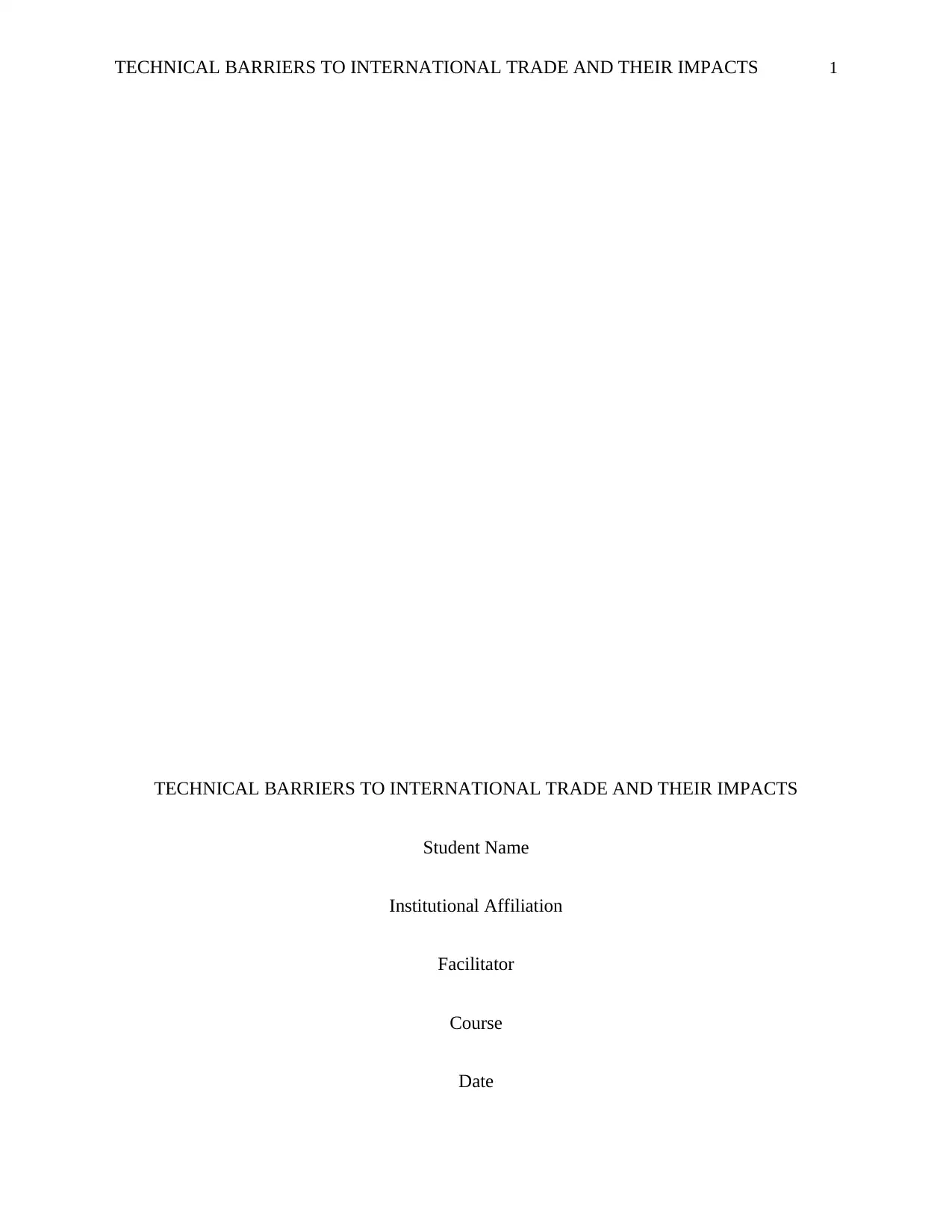
TECHNICAL BARRIERS TO INTERNATIONAL TRADE AND THEIR IMPACTS 1
TECHNICAL BARRIERS TO INTERNATIONAL TRADE AND THEIR IMPACTS
Student Name
Institutional Affiliation
Facilitator
Course
Date
TECHNICAL BARRIERS TO INTERNATIONAL TRADE AND THEIR IMPACTS
Student Name
Institutional Affiliation
Facilitator
Course
Date
Secure Best Marks with AI Grader
Need help grading? Try our AI Grader for instant feedback on your assignments.
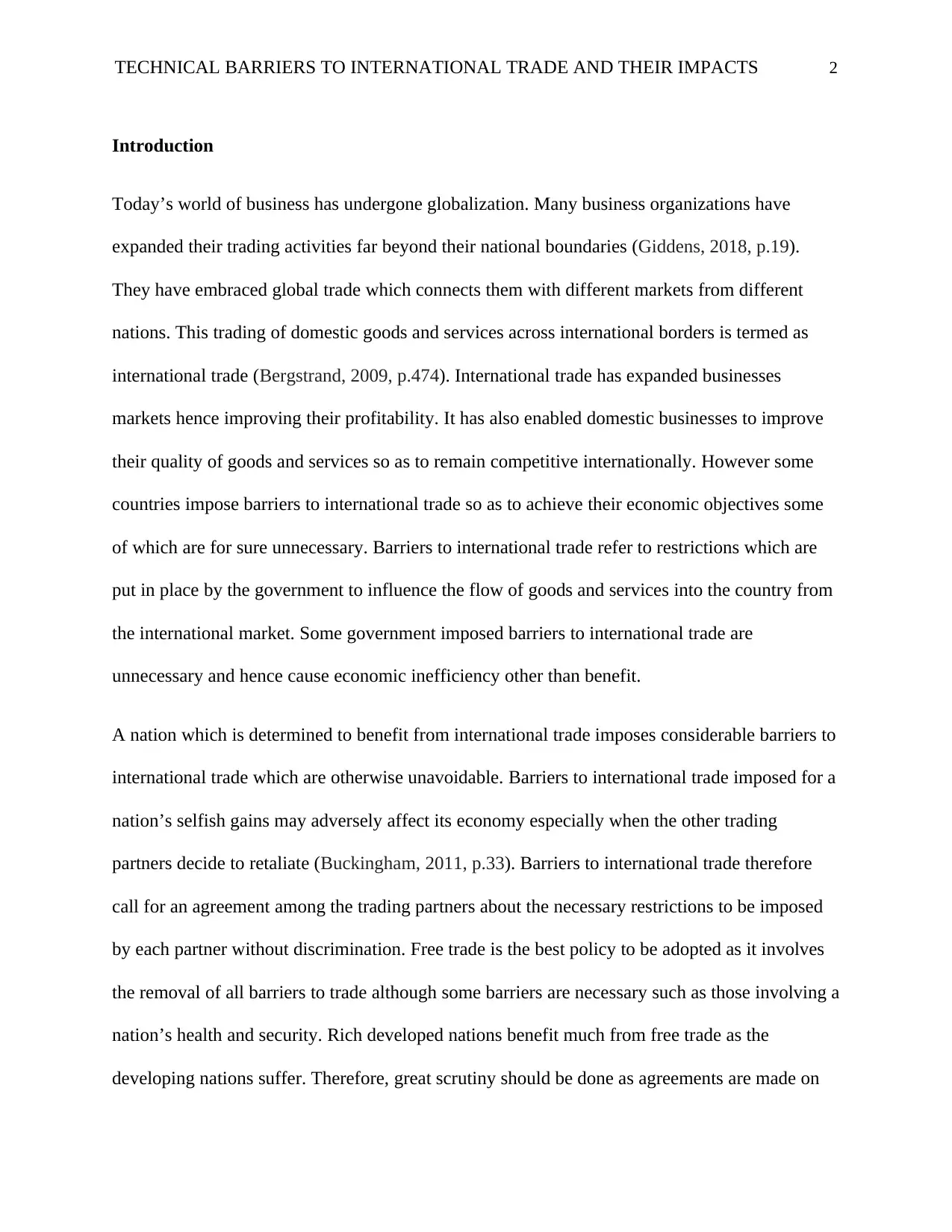
TECHNICAL BARRIERS TO INTERNATIONAL TRADE AND THEIR IMPACTS 2
Introduction
Today’s world of business has undergone globalization. Many business organizations have
expanded their trading activities far beyond their national boundaries (Giddens, 2018, p.19).
They have embraced global trade which connects them with different markets from different
nations. This trading of domestic goods and services across international borders is termed as
international trade (Bergstrand, 2009, p.474). International trade has expanded businesses
markets hence improving their profitability. It has also enabled domestic businesses to improve
their quality of goods and services so as to remain competitive internationally. However some
countries impose barriers to international trade so as to achieve their economic objectives some
of which are for sure unnecessary. Barriers to international trade refer to restrictions which are
put in place by the government to influence the flow of goods and services into the country from
the international market. Some government imposed barriers to international trade are
unnecessary and hence cause economic inefficiency other than benefit.
A nation which is determined to benefit from international trade imposes considerable barriers to
international trade which are otherwise unavoidable. Barriers to international trade imposed for a
nation’s selfish gains may adversely affect its economy especially when the other trading
partners decide to retaliate (Buckingham, 2011, p.33). Barriers to international trade therefore
call for an agreement among the trading partners about the necessary restrictions to be imposed
by each partner without discrimination. Free trade is the best policy to be adopted as it involves
the removal of all barriers to trade although some barriers are necessary such as those involving a
nation’s health and security. Rich developed nations benefit much from free trade as the
developing nations suffer. Therefore, great scrutiny should be done as agreements are made on
Introduction
Today’s world of business has undergone globalization. Many business organizations have
expanded their trading activities far beyond their national boundaries (Giddens, 2018, p.19).
They have embraced global trade which connects them with different markets from different
nations. This trading of domestic goods and services across international borders is termed as
international trade (Bergstrand, 2009, p.474). International trade has expanded businesses
markets hence improving their profitability. It has also enabled domestic businesses to improve
their quality of goods and services so as to remain competitive internationally. However some
countries impose barriers to international trade so as to achieve their economic objectives some
of which are for sure unnecessary. Barriers to international trade refer to restrictions which are
put in place by the government to influence the flow of goods and services into the country from
the international market. Some government imposed barriers to international trade are
unnecessary and hence cause economic inefficiency other than benefit.
A nation which is determined to benefit from international trade imposes considerable barriers to
international trade which are otherwise unavoidable. Barriers to international trade imposed for a
nation’s selfish gains may adversely affect its economy especially when the other trading
partners decide to retaliate (Buckingham, 2011, p.33). Barriers to international trade therefore
call for an agreement among the trading partners about the necessary restrictions to be imposed
by each partner without discrimination. Free trade is the best policy to be adopted as it involves
the removal of all barriers to trade although some barriers are necessary such as those involving a
nation’s health and security. Rich developed nations benefit much from free trade as the
developing nations suffer. Therefore, great scrutiny should be done as agreements are made on
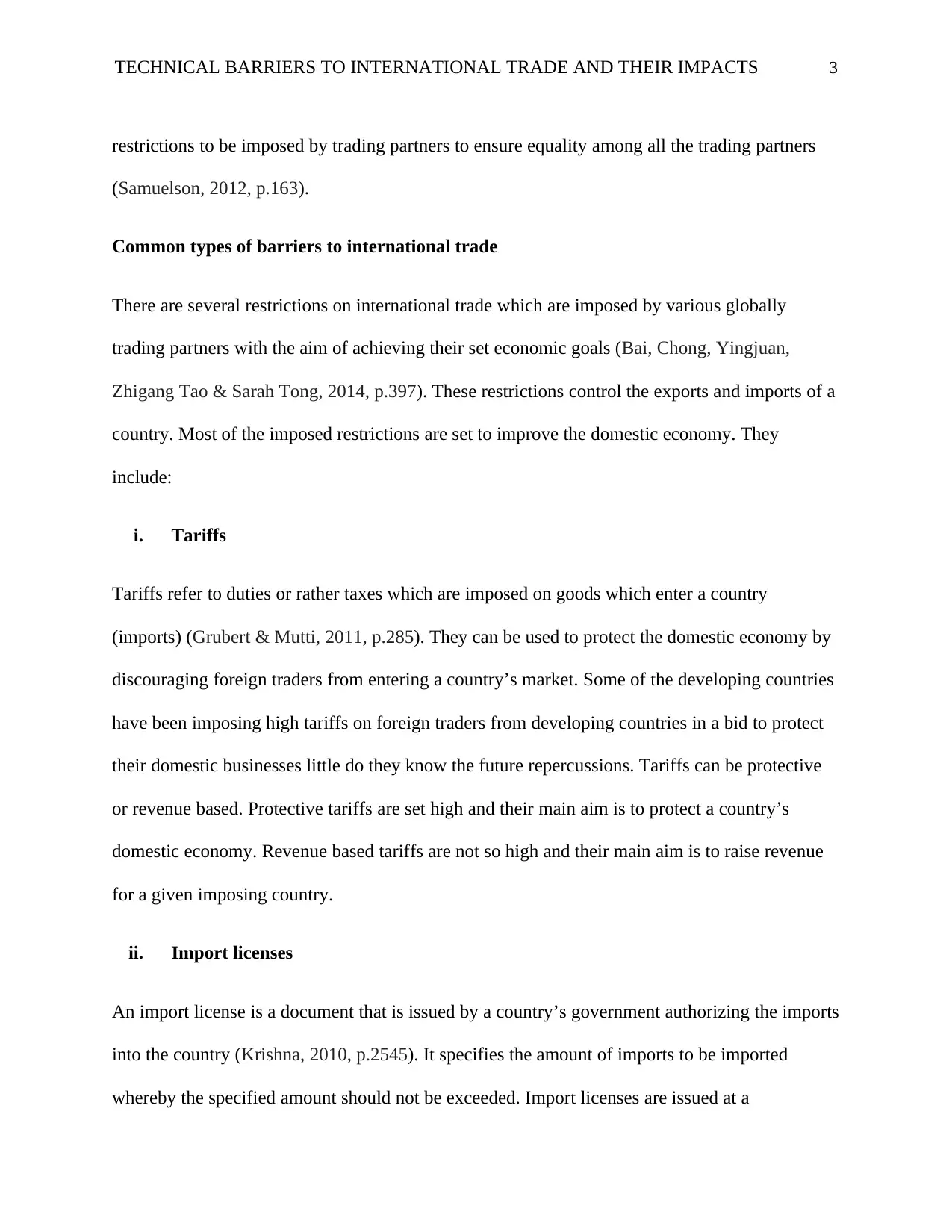
TECHNICAL BARRIERS TO INTERNATIONAL TRADE AND THEIR IMPACTS 3
restrictions to be imposed by trading partners to ensure equality among all the trading partners
(Samuelson, 2012, p.163).
Common types of barriers to international trade
There are several restrictions on international trade which are imposed by various globally
trading partners with the aim of achieving their set economic goals (Bai, Chong, Yingjuan,
Zhigang Tao & Sarah Tong, 2014, p.397). These restrictions control the exports and imports of a
country. Most of the imposed restrictions are set to improve the domestic economy. They
include:
i. Tariffs
Tariffs refer to duties or rather taxes which are imposed on goods which enter a country
(imports) (Grubert & Mutti, 2011, p.285). They can be used to protect the domestic economy by
discouraging foreign traders from entering a country’s market. Some of the developing countries
have been imposing high tariffs on foreign traders from developing countries in a bid to protect
their domestic businesses little do they know the future repercussions. Tariffs can be protective
or revenue based. Protective tariffs are set high and their main aim is to protect a country’s
domestic economy. Revenue based tariffs are not so high and their main aim is to raise revenue
for a given imposing country.
ii. Import licenses
An import license is a document that is issued by a country’s government authorizing the imports
into the country (Krishna, 2010, p.2545). It specifies the amount of imports to be imported
whereby the specified amount should not be exceeded. Import licenses are issued at a
restrictions to be imposed by trading partners to ensure equality among all the trading partners
(Samuelson, 2012, p.163).
Common types of barriers to international trade
There are several restrictions on international trade which are imposed by various globally
trading partners with the aim of achieving their set economic goals (Bai, Chong, Yingjuan,
Zhigang Tao & Sarah Tong, 2014, p.397). These restrictions control the exports and imports of a
country. Most of the imposed restrictions are set to improve the domestic economy. They
include:
i. Tariffs
Tariffs refer to duties or rather taxes which are imposed on goods which enter a country
(imports) (Grubert & Mutti, 2011, p.285). They can be used to protect the domestic economy by
discouraging foreign traders from entering a country’s market. Some of the developing countries
have been imposing high tariffs on foreign traders from developing countries in a bid to protect
their domestic businesses little do they know the future repercussions. Tariffs can be protective
or revenue based. Protective tariffs are set high and their main aim is to protect a country’s
domestic economy. Revenue based tariffs are not so high and their main aim is to raise revenue
for a given imposing country.
ii. Import licenses
An import license is a document that is issued by a country’s government authorizing the imports
into the country (Krishna, 2010, p.2545). It specifies the amount of imports to be imported
whereby the specified amount should not be exceeded. Import licenses are issued at a
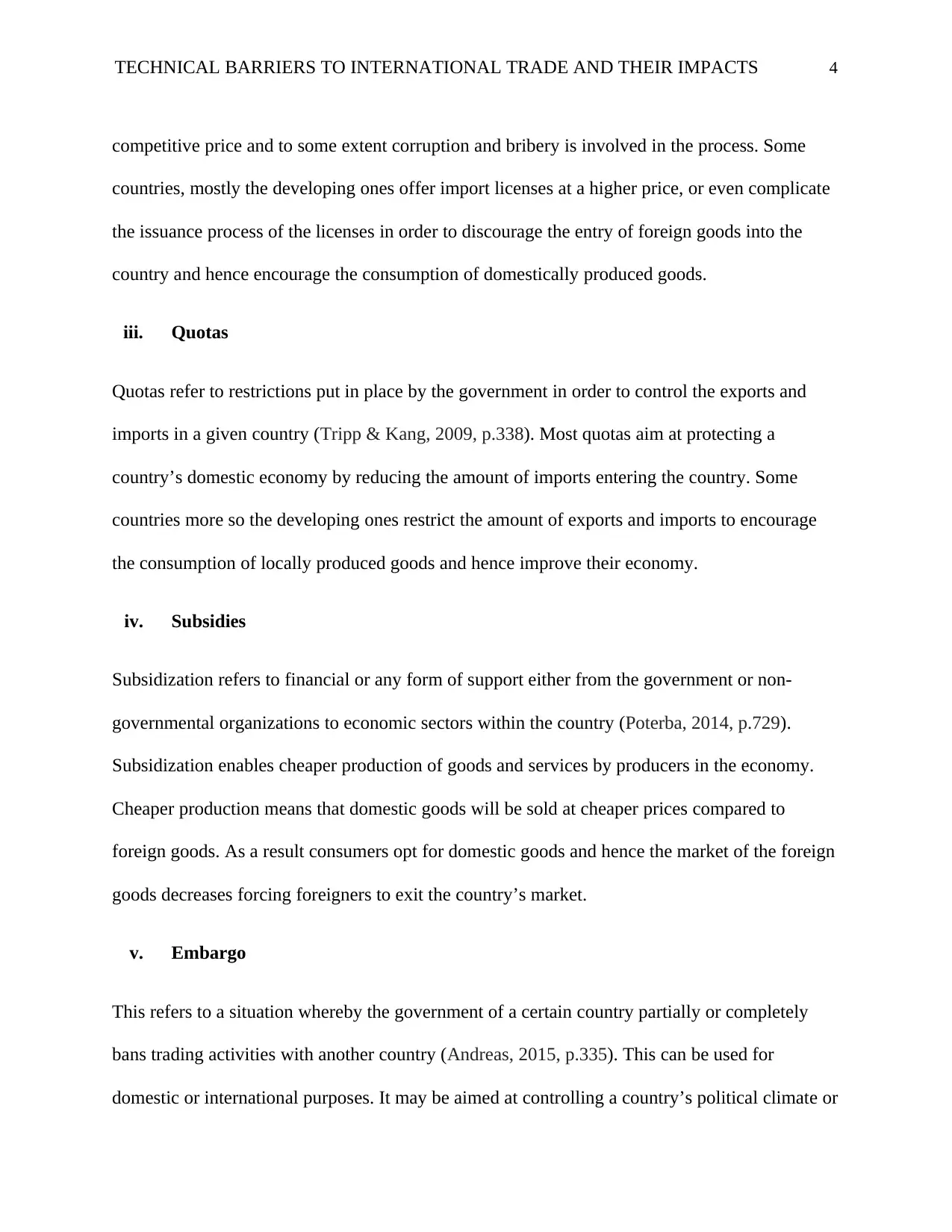
TECHNICAL BARRIERS TO INTERNATIONAL TRADE AND THEIR IMPACTS 4
competitive price and to some extent corruption and bribery is involved in the process. Some
countries, mostly the developing ones offer import licenses at a higher price, or even complicate
the issuance process of the licenses in order to discourage the entry of foreign goods into the
country and hence encourage the consumption of domestically produced goods.
iii. Quotas
Quotas refer to restrictions put in place by the government in order to control the exports and
imports in a given country (Tripp & Kang, 2009, p.338). Most quotas aim at protecting a
country’s domestic economy by reducing the amount of imports entering the country. Some
countries more so the developing ones restrict the amount of exports and imports to encourage
the consumption of locally produced goods and hence improve their economy.
iv. Subsidies
Subsidization refers to financial or any form of support either from the government or non-
governmental organizations to economic sectors within the country (Poterba, 2014, p.729).
Subsidization enables cheaper production of goods and services by producers in the economy.
Cheaper production means that domestic goods will be sold at cheaper prices compared to
foreign goods. As a result consumers opt for domestic goods and hence the market of the foreign
goods decreases forcing foreigners to exit the country’s market.
v. Embargo
This refers to a situation whereby the government of a certain country partially or completely
bans trading activities with another country (Andreas, 2015, p.335). This can be used for
domestic or international purposes. It may be aimed at controlling a country’s political climate or
competitive price and to some extent corruption and bribery is involved in the process. Some
countries, mostly the developing ones offer import licenses at a higher price, or even complicate
the issuance process of the licenses in order to discourage the entry of foreign goods into the
country and hence encourage the consumption of domestically produced goods.
iii. Quotas
Quotas refer to restrictions put in place by the government in order to control the exports and
imports in a given country (Tripp & Kang, 2009, p.338). Most quotas aim at protecting a
country’s domestic economy by reducing the amount of imports entering the country. Some
countries more so the developing ones restrict the amount of exports and imports to encourage
the consumption of locally produced goods and hence improve their economy.
iv. Subsidies
Subsidization refers to financial or any form of support either from the government or non-
governmental organizations to economic sectors within the country (Poterba, 2014, p.729).
Subsidization enables cheaper production of goods and services by producers in the economy.
Cheaper production means that domestic goods will be sold at cheaper prices compared to
foreign goods. As a result consumers opt for domestic goods and hence the market of the foreign
goods decreases forcing foreigners to exit the country’s market.
v. Embargo
This refers to a situation whereby the government of a certain country partially or completely
bans trading activities with another country (Andreas, 2015, p.335). This can be used for
domestic or international purposes. It may be aimed at controlling a country’s political climate or
Secure Best Marks with AI Grader
Need help grading? Try our AI Grader for instant feedback on your assignments.
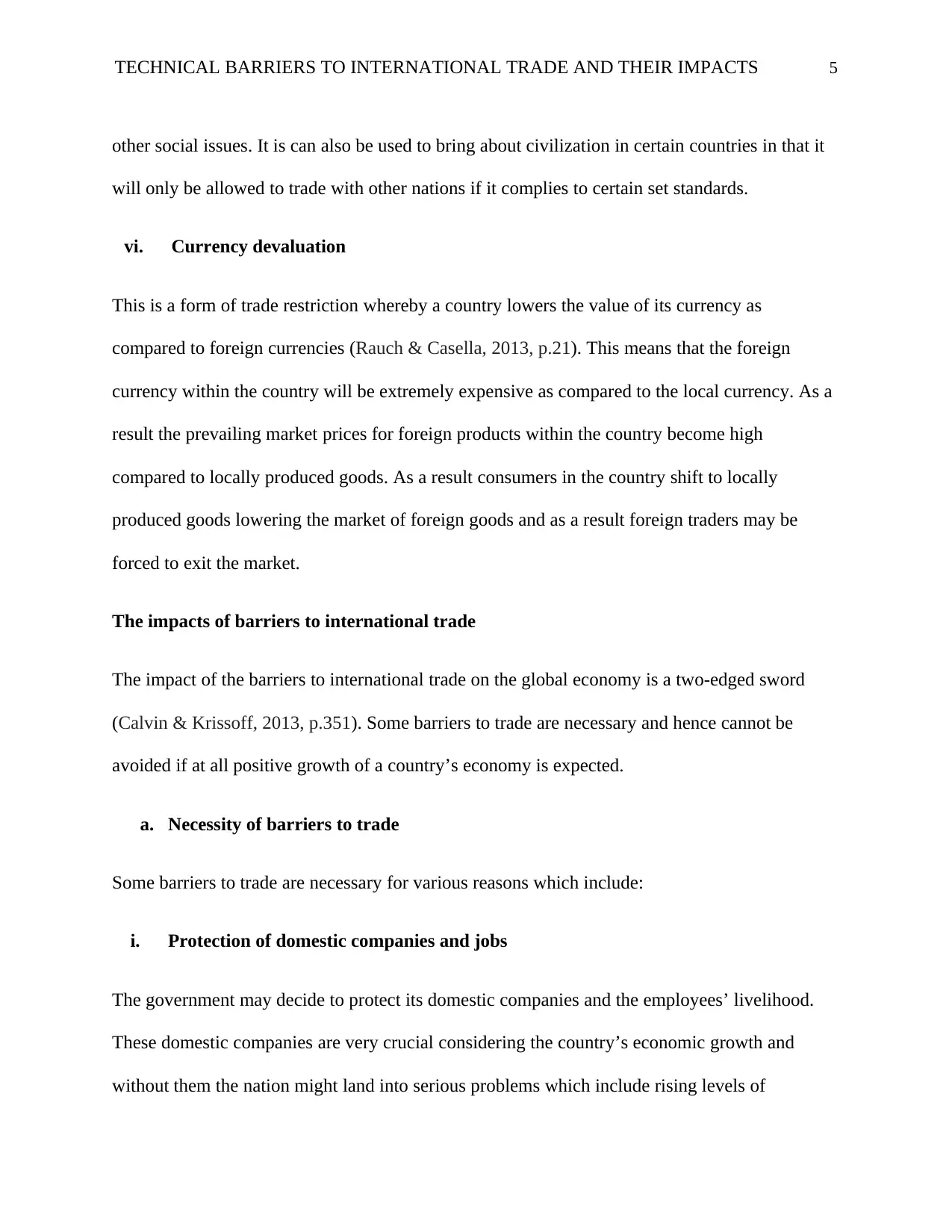
TECHNICAL BARRIERS TO INTERNATIONAL TRADE AND THEIR IMPACTS 5
other social issues. It is can also be used to bring about civilization in certain countries in that it
will only be allowed to trade with other nations if it complies to certain set standards.
vi. Currency devaluation
This is a form of trade restriction whereby a country lowers the value of its currency as
compared to foreign currencies (Rauch & Casella, 2013, p.21). This means that the foreign
currency within the country will be extremely expensive as compared to the local currency. As a
result the prevailing market prices for foreign products within the country become high
compared to locally produced goods. As a result consumers in the country shift to locally
produced goods lowering the market of foreign goods and as a result foreign traders may be
forced to exit the market.
The impacts of barriers to international trade
The impact of the barriers to international trade on the global economy is a two-edged sword
(Calvin & Krissoff, 2013, p.351). Some barriers to trade are necessary and hence cannot be
avoided if at all positive growth of a country’s economy is expected.
a. Necessity of barriers to trade
Some barriers to trade are necessary for various reasons which include:
i. Protection of domestic companies and jobs
The government may decide to protect its domestic companies and the employees’ livelihood.
These domestic companies are very crucial considering the country’s economic growth and
without them the nation might land into serious problems which include rising levels of
other social issues. It is can also be used to bring about civilization in certain countries in that it
will only be allowed to trade with other nations if it complies to certain set standards.
vi. Currency devaluation
This is a form of trade restriction whereby a country lowers the value of its currency as
compared to foreign currencies (Rauch & Casella, 2013, p.21). This means that the foreign
currency within the country will be extremely expensive as compared to the local currency. As a
result the prevailing market prices for foreign products within the country become high
compared to locally produced goods. As a result consumers in the country shift to locally
produced goods lowering the market of foreign goods and as a result foreign traders may be
forced to exit the market.
The impacts of barriers to international trade
The impact of the barriers to international trade on the global economy is a two-edged sword
(Calvin & Krissoff, 2013, p.351). Some barriers to trade are necessary and hence cannot be
avoided if at all positive growth of a country’s economy is expected.
a. Necessity of barriers to trade
Some barriers to trade are necessary for various reasons which include:
i. Protection of domestic companies and jobs
The government may decide to protect its domestic companies and the employees’ livelihood.
These domestic companies are very crucial considering the country’s economic growth and
without them the nation might land into serious problems which include rising levels of
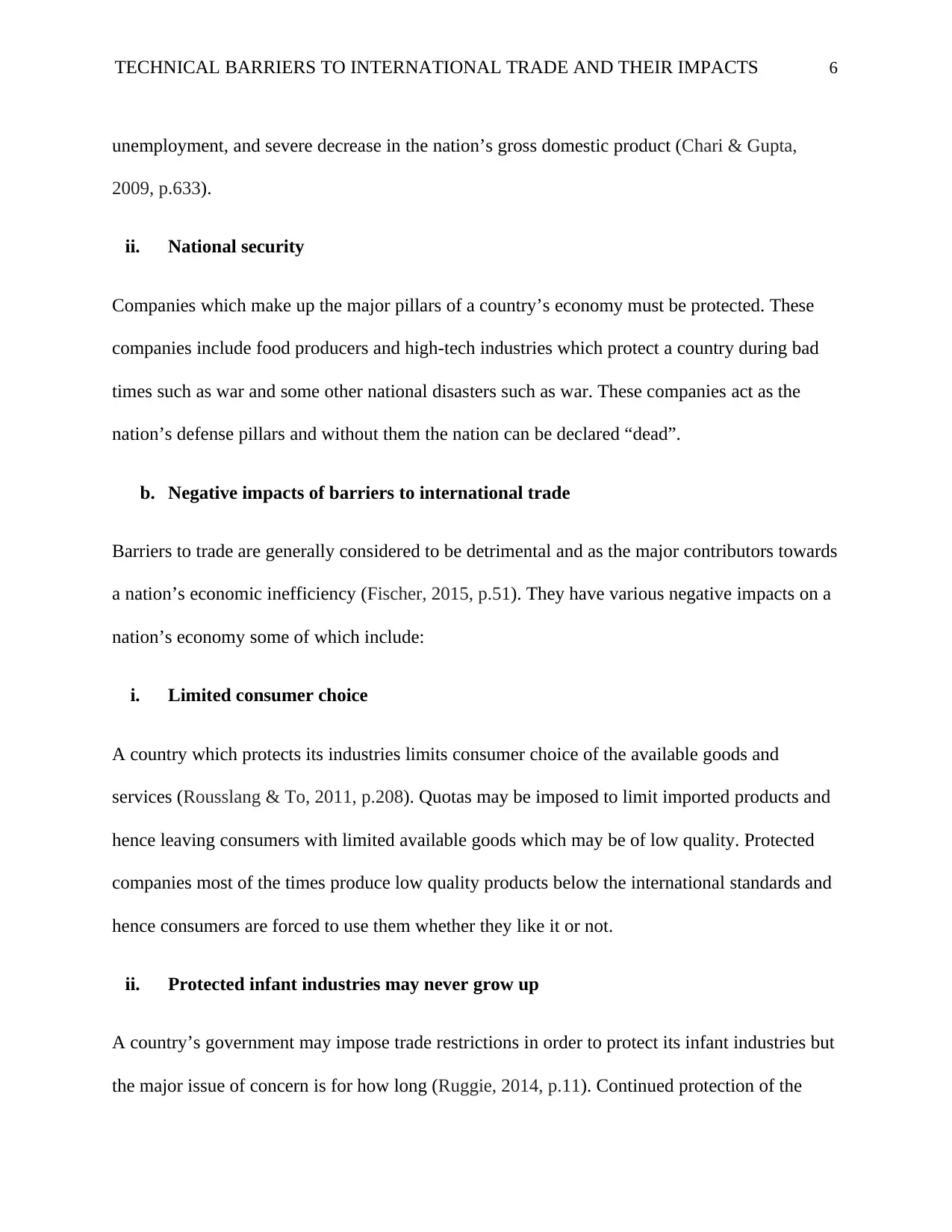
TECHNICAL BARRIERS TO INTERNATIONAL TRADE AND THEIR IMPACTS 6
unemployment, and severe decrease in the nation’s gross domestic product (Chari & Gupta,
2009, p.633).
ii. National security
Companies which make up the major pillars of a country’s economy must be protected. These
companies include food producers and high-tech industries which protect a country during bad
times such as war and some other national disasters such as war. These companies act as the
nation’s defense pillars and without them the nation can be declared “dead”.
b. Negative impacts of barriers to international trade
Barriers to trade are generally considered to be detrimental and as the major contributors towards
a nation’s economic inefficiency (Fischer, 2015, p.51). They have various negative impacts on a
nation’s economy some of which include:
i. Limited consumer choice
A country which protects its industries limits consumer choice of the available goods and
services (Rousslang & To, 2011, p.208). Quotas may be imposed to limit imported products and
hence leaving consumers with limited available goods which may be of low quality. Protected
companies most of the times produce low quality products below the international standards and
hence consumers are forced to use them whether they like it or not.
ii. Protected infant industries may never grow up
A country’s government may impose trade restrictions in order to protect its infant industries but
the major issue of concern is for how long (Ruggie, 2014, p.11). Continued protection of the
unemployment, and severe decrease in the nation’s gross domestic product (Chari & Gupta,
2009, p.633).
ii. National security
Companies which make up the major pillars of a country’s economy must be protected. These
companies include food producers and high-tech industries which protect a country during bad
times such as war and some other national disasters such as war. These companies act as the
nation’s defense pillars and without them the nation can be declared “dead”.
b. Negative impacts of barriers to international trade
Barriers to trade are generally considered to be detrimental and as the major contributors towards
a nation’s economic inefficiency (Fischer, 2015, p.51). They have various negative impacts on a
nation’s economy some of which include:
i. Limited consumer choice
A country which protects its industries limits consumer choice of the available goods and
services (Rousslang & To, 2011, p.208). Quotas may be imposed to limit imported products and
hence leaving consumers with limited available goods which may be of low quality. Protected
companies most of the times produce low quality products below the international standards and
hence consumers are forced to use them whether they like it or not.
ii. Protected infant industries may never grow up
A country’s government may impose trade restrictions in order to protect its infant industries but
the major issue of concern is for how long (Ruggie, 2014, p.11). Continued protection of the

TECHNICAL BARRIERS TO INTERNATIONAL TRADE AND THEIR IMPACTS 7
infant industries leave them unexposed to the international market which can help shape them
and enable them to grow to international standards. These infant industries continue being
inefficient in their productivity and may never attain international production standards.
iii. Long-term inflation
This is brought about by a country devaluing its currency. A country may decide to lower the
value of its currency so as to sell its exports in the international market at relatively cheaper
prices than its trading partners. In case any foreign goods and services happen to be sold in the
country’s market, the price of these commodities will definitely be high (Takacs, 2011, p.687).
Consumers are hence forced to pay high prices for foreign goods and services which may be
necessities and this may cause inflation in the country.
iv. Possible retaliation by trading partners
A country may enter into trade war with other nations. This is the case when the other nations
react to restrictions put in place by a trading government partner (Johnson, 2013, p.31). The
other trading partners may find it hard to sell their products the way they used to do and as a
result they may also impose their barriers to trade to prevent the other nation from participating
in the international trade too. This was the case with the United States and Japan though they
later on reconciled.
Recommendations
Barriers to international trade make an economy inefficient and if not carefully addressed it may
end up dragging behind in terms of economic development.
infant industries leave them unexposed to the international market which can help shape them
and enable them to grow to international standards. These infant industries continue being
inefficient in their productivity and may never attain international production standards.
iii. Long-term inflation
This is brought about by a country devaluing its currency. A country may decide to lower the
value of its currency so as to sell its exports in the international market at relatively cheaper
prices than its trading partners. In case any foreign goods and services happen to be sold in the
country’s market, the price of these commodities will definitely be high (Takacs, 2011, p.687).
Consumers are hence forced to pay high prices for foreign goods and services which may be
necessities and this may cause inflation in the country.
iv. Possible retaliation by trading partners
A country may enter into trade war with other nations. This is the case when the other nations
react to restrictions put in place by a trading government partner (Johnson, 2013, p.31). The
other trading partners may find it hard to sell their products the way they used to do and as a
result they may also impose their barriers to trade to prevent the other nation from participating
in the international trade too. This was the case with the United States and Japan though they
later on reconciled.
Recommendations
Barriers to international trade make an economy inefficient and if not carefully addressed it may
end up dragging behind in terms of economic development.
Paraphrase This Document
Need a fresh take? Get an instant paraphrase of this document with our AI Paraphraser
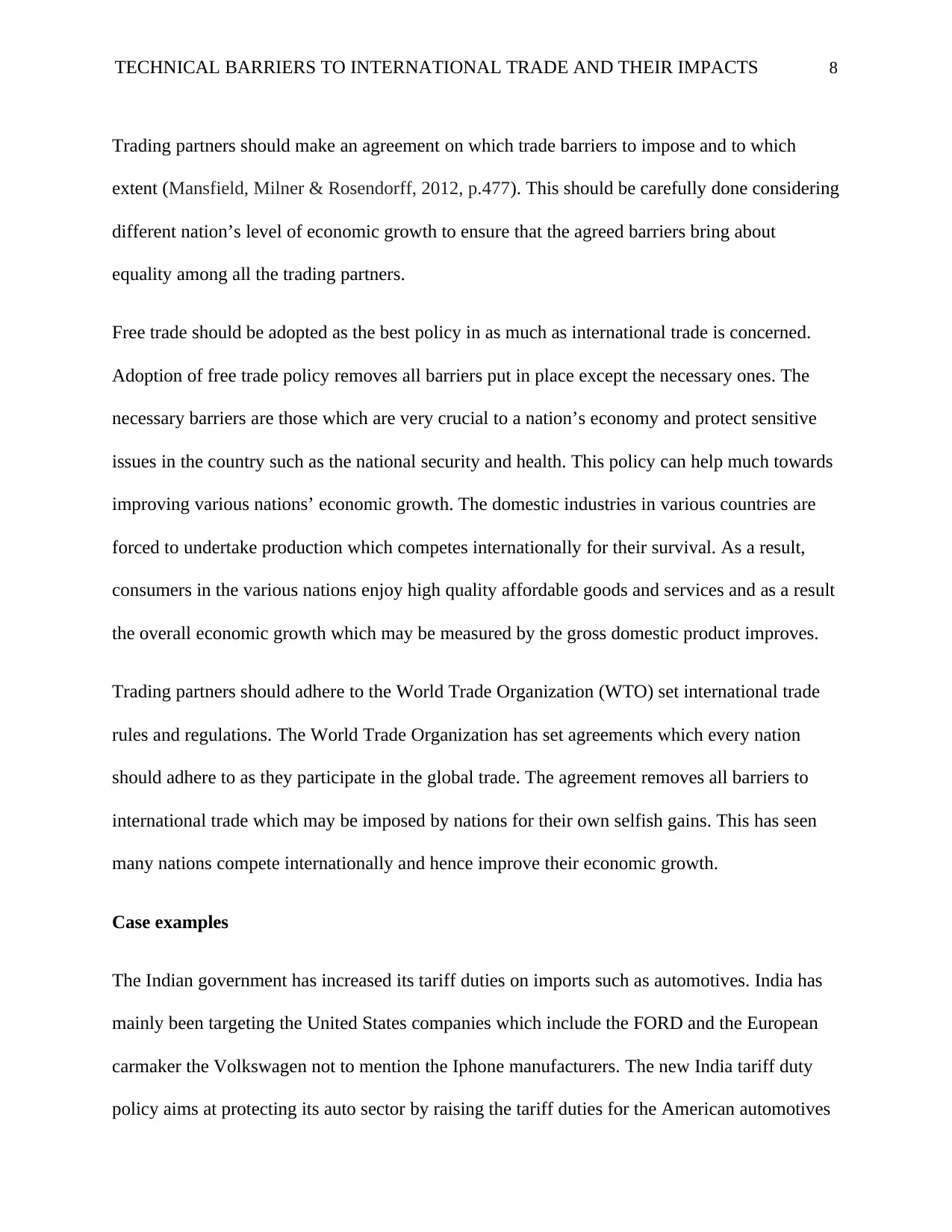
TECHNICAL BARRIERS TO INTERNATIONAL TRADE AND THEIR IMPACTS 8
Trading partners should make an agreement on which trade barriers to impose and to which
extent (Mansfield, Milner & Rosendorff, 2012, p.477). This should be carefully done considering
different nation’s level of economic growth to ensure that the agreed barriers bring about
equality among all the trading partners.
Free trade should be adopted as the best policy in as much as international trade is concerned.
Adoption of free trade policy removes all barriers put in place except the necessary ones. The
necessary barriers are those which are very crucial to a nation’s economy and protect sensitive
issues in the country such as the national security and health. This policy can help much towards
improving various nations’ economic growth. The domestic industries in various countries are
forced to undertake production which competes internationally for their survival. As a result,
consumers in the various nations enjoy high quality affordable goods and services and as a result
the overall economic growth which may be measured by the gross domestic product improves.
Trading partners should adhere to the World Trade Organization (WTO) set international trade
rules and regulations. The World Trade Organization has set agreements which every nation
should adhere to as they participate in the global trade. The agreement removes all barriers to
international trade which may be imposed by nations for their own selfish gains. This has seen
many nations compete internationally and hence improve their economic growth.
Case examples
The Indian government has increased its tariff duties on imports such as automotives. India has
mainly been targeting the United States companies which include the FORD and the European
carmaker the Volkswagen not to mention the Iphone manufacturers. The new India tariff duty
policy aims at protecting its auto sector by raising the tariff duties for the American automotives
Trading partners should make an agreement on which trade barriers to impose and to which
extent (Mansfield, Milner & Rosendorff, 2012, p.477). This should be carefully done considering
different nation’s level of economic growth to ensure that the agreed barriers bring about
equality among all the trading partners.
Free trade should be adopted as the best policy in as much as international trade is concerned.
Adoption of free trade policy removes all barriers put in place except the necessary ones. The
necessary barriers are those which are very crucial to a nation’s economy and protect sensitive
issues in the country such as the national security and health. This policy can help much towards
improving various nations’ economic growth. The domestic industries in various countries are
forced to undertake production which competes internationally for their survival. As a result,
consumers in the various nations enjoy high quality affordable goods and services and as a result
the overall economic growth which may be measured by the gross domestic product improves.
Trading partners should adhere to the World Trade Organization (WTO) set international trade
rules and regulations. The World Trade Organization has set agreements which every nation
should adhere to as they participate in the global trade. The agreement removes all barriers to
international trade which may be imposed by nations for their own selfish gains. This has seen
many nations compete internationally and hence improve their economic growth.
Case examples
The Indian government has increased its tariff duties on imports such as automotives. India has
mainly been targeting the United States companies which include the FORD and the European
carmaker the Volkswagen not to mention the Iphone manufacturers. The new India tariff duty
policy aims at protecting its auto sector by raising the tariff duties for the American automotives
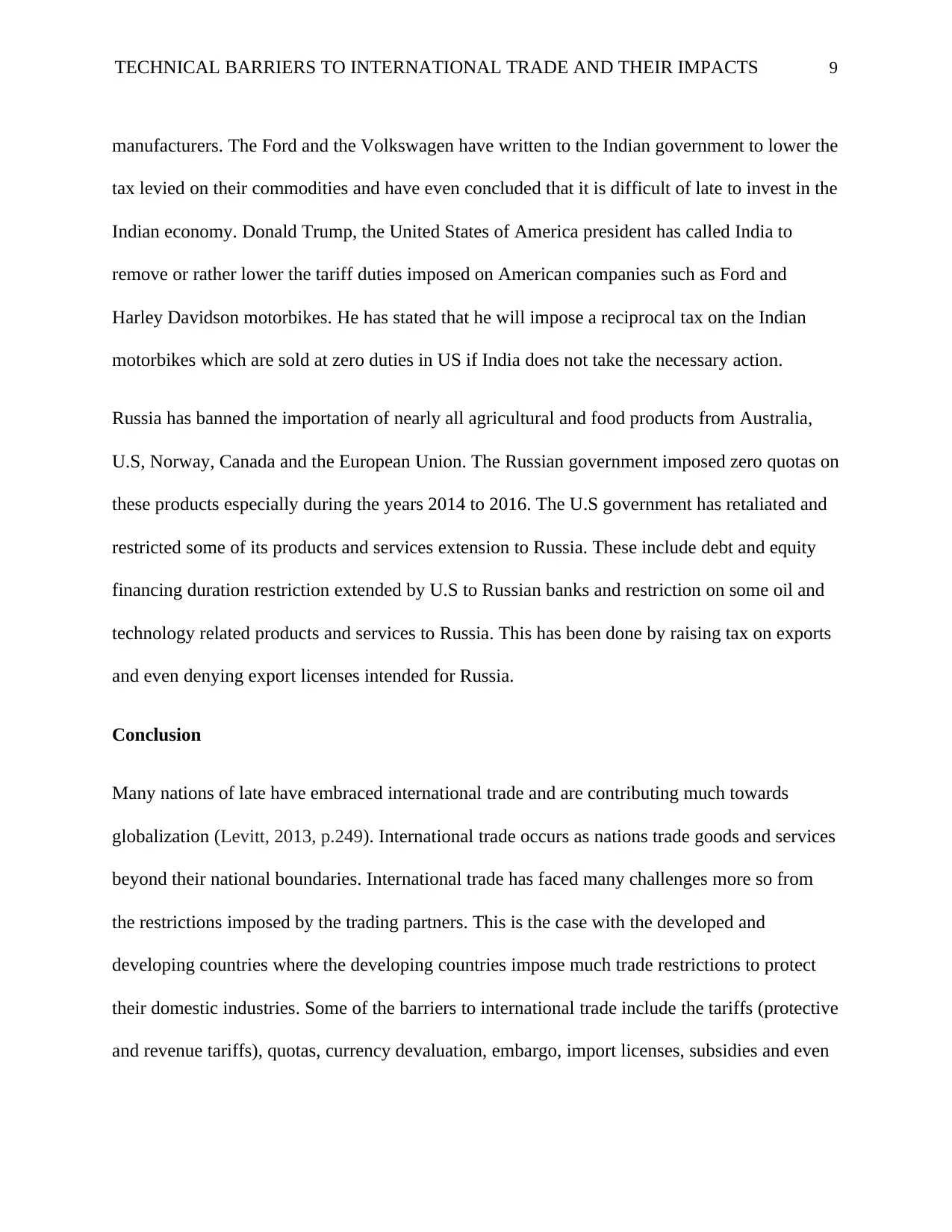
TECHNICAL BARRIERS TO INTERNATIONAL TRADE AND THEIR IMPACTS 9
manufacturers. The Ford and the Volkswagen have written to the Indian government to lower the
tax levied on their commodities and have even concluded that it is difficult of late to invest in the
Indian economy. Donald Trump, the United States of America president has called India to
remove or rather lower the tariff duties imposed on American companies such as Ford and
Harley Davidson motorbikes. He has stated that he will impose a reciprocal tax on the Indian
motorbikes which are sold at zero duties in US if India does not take the necessary action.
Russia has banned the importation of nearly all agricultural and food products from Australia,
U.S, Norway, Canada and the European Union. The Russian government imposed zero quotas on
these products especially during the years 2014 to 2016. The U.S government has retaliated and
restricted some of its products and services extension to Russia. These include debt and equity
financing duration restriction extended by U.S to Russian banks and restriction on some oil and
technology related products and services to Russia. This has been done by raising tax on exports
and even denying export licenses intended for Russia.
Conclusion
Many nations of late have embraced international trade and are contributing much towards
globalization (Levitt, 2013, p.249). International trade occurs as nations trade goods and services
beyond their national boundaries. International trade has faced many challenges more so from
the restrictions imposed by the trading partners. This is the case with the developed and
developing countries where the developing countries impose much trade restrictions to protect
their domestic industries. Some of the barriers to international trade include the tariffs (protective
and revenue tariffs), quotas, currency devaluation, embargo, import licenses, subsidies and even
manufacturers. The Ford and the Volkswagen have written to the Indian government to lower the
tax levied on their commodities and have even concluded that it is difficult of late to invest in the
Indian economy. Donald Trump, the United States of America president has called India to
remove or rather lower the tariff duties imposed on American companies such as Ford and
Harley Davidson motorbikes. He has stated that he will impose a reciprocal tax on the Indian
motorbikes which are sold at zero duties in US if India does not take the necessary action.
Russia has banned the importation of nearly all agricultural and food products from Australia,
U.S, Norway, Canada and the European Union. The Russian government imposed zero quotas on
these products especially during the years 2014 to 2016. The U.S government has retaliated and
restricted some of its products and services extension to Russia. These include debt and equity
financing duration restriction extended by U.S to Russian banks and restriction on some oil and
technology related products and services to Russia. This has been done by raising tax on exports
and even denying export licenses intended for Russia.
Conclusion
Many nations of late have embraced international trade and are contributing much towards
globalization (Levitt, 2013, p.249). International trade occurs as nations trade goods and services
beyond their national boundaries. International trade has faced many challenges more so from
the restrictions imposed by the trading partners. This is the case with the developed and
developing countries where the developing countries impose much trade restrictions to protect
their domestic industries. Some of the barriers to international trade include the tariffs (protective
and revenue tariffs), quotas, currency devaluation, embargo, import licenses, subsidies and even
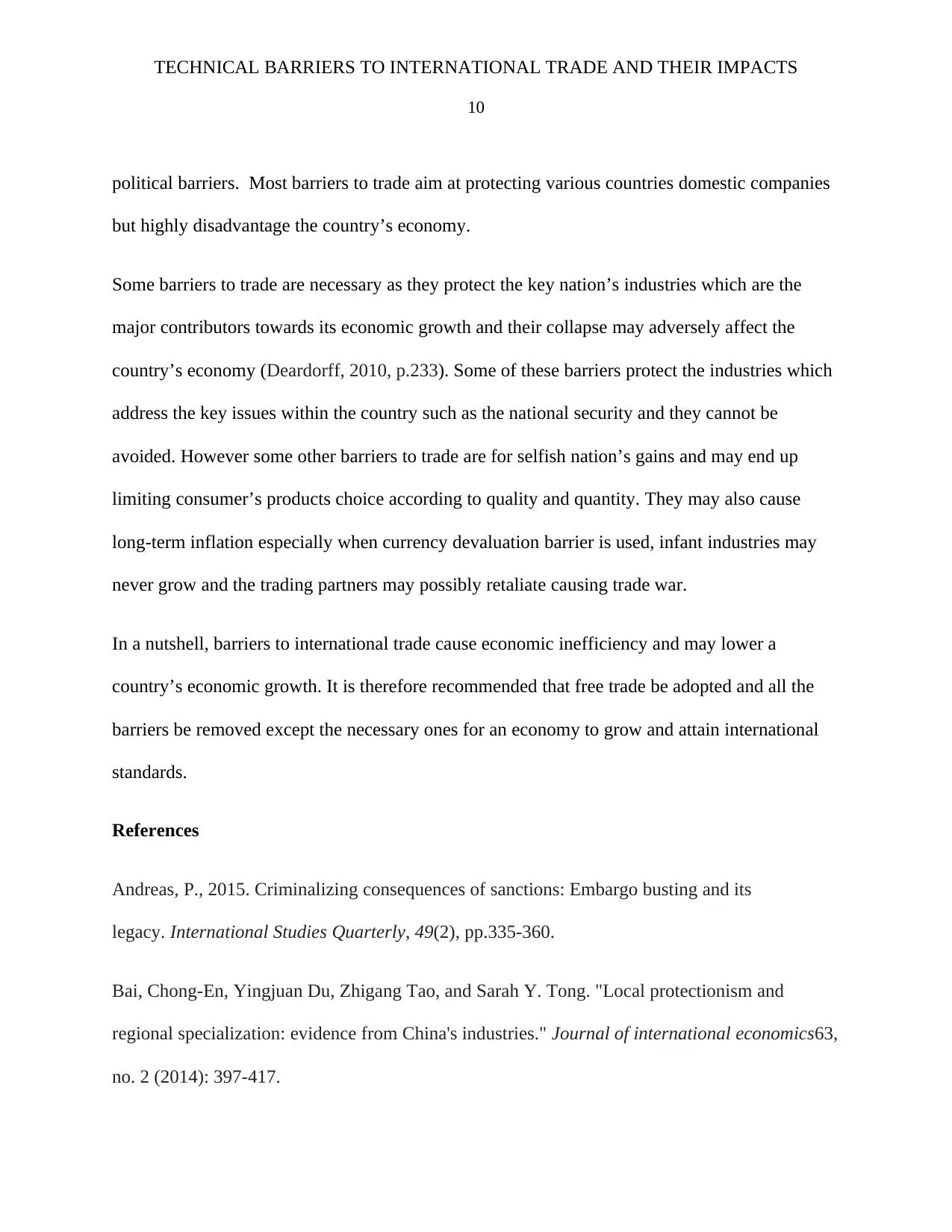
TECHNICAL BARRIERS TO INTERNATIONAL TRADE AND THEIR IMPACTS
10
political barriers. Most barriers to trade aim at protecting various countries domestic companies
but highly disadvantage the country’s economy.
Some barriers to trade are necessary as they protect the key nation’s industries which are the
major contributors towards its economic growth and their collapse may adversely affect the
country’s economy (Deardorff, 2010, p.233). Some of these barriers protect the industries which
address the key issues within the country such as the national security and they cannot be
avoided. However some other barriers to trade are for selfish nation’s gains and may end up
limiting consumer’s products choice according to quality and quantity. They may also cause
long-term inflation especially when currency devaluation barrier is used, infant industries may
never grow and the trading partners may possibly retaliate causing trade war.
In a nutshell, barriers to international trade cause economic inefficiency and may lower a
country’s economic growth. It is therefore recommended that free trade be adopted and all the
barriers be removed except the necessary ones for an economy to grow and attain international
standards.
References
Andreas, P., 2015. Criminalizing consequences of sanctions: Embargo busting and its
legacy. International Studies Quarterly, 49(2), pp.335-360.
Bai, Chong-En, Yingjuan Du, Zhigang Tao, and Sarah Y. Tong. "Local protectionism and
regional specialization: evidence from China's industries." Journal of international economics63,
no. 2 (2014): 397-417.
10
political barriers. Most barriers to trade aim at protecting various countries domestic companies
but highly disadvantage the country’s economy.
Some barriers to trade are necessary as they protect the key nation’s industries which are the
major contributors towards its economic growth and their collapse may adversely affect the
country’s economy (Deardorff, 2010, p.233). Some of these barriers protect the industries which
address the key issues within the country such as the national security and they cannot be
avoided. However some other barriers to trade are for selfish nation’s gains and may end up
limiting consumer’s products choice according to quality and quantity. They may also cause
long-term inflation especially when currency devaluation barrier is used, infant industries may
never grow and the trading partners may possibly retaliate causing trade war.
In a nutshell, barriers to international trade cause economic inefficiency and may lower a
country’s economic growth. It is therefore recommended that free trade be adopted and all the
barriers be removed except the necessary ones for an economy to grow and attain international
standards.
References
Andreas, P., 2015. Criminalizing consequences of sanctions: Embargo busting and its
legacy. International Studies Quarterly, 49(2), pp.335-360.
Bai, Chong-En, Yingjuan Du, Zhigang Tao, and Sarah Y. Tong. "Local protectionism and
regional specialization: evidence from China's industries." Journal of international economics63,
no. 2 (2014): 397-417.
Secure Best Marks with AI Grader
Need help grading? Try our AI Grader for instant feedback on your assignments.
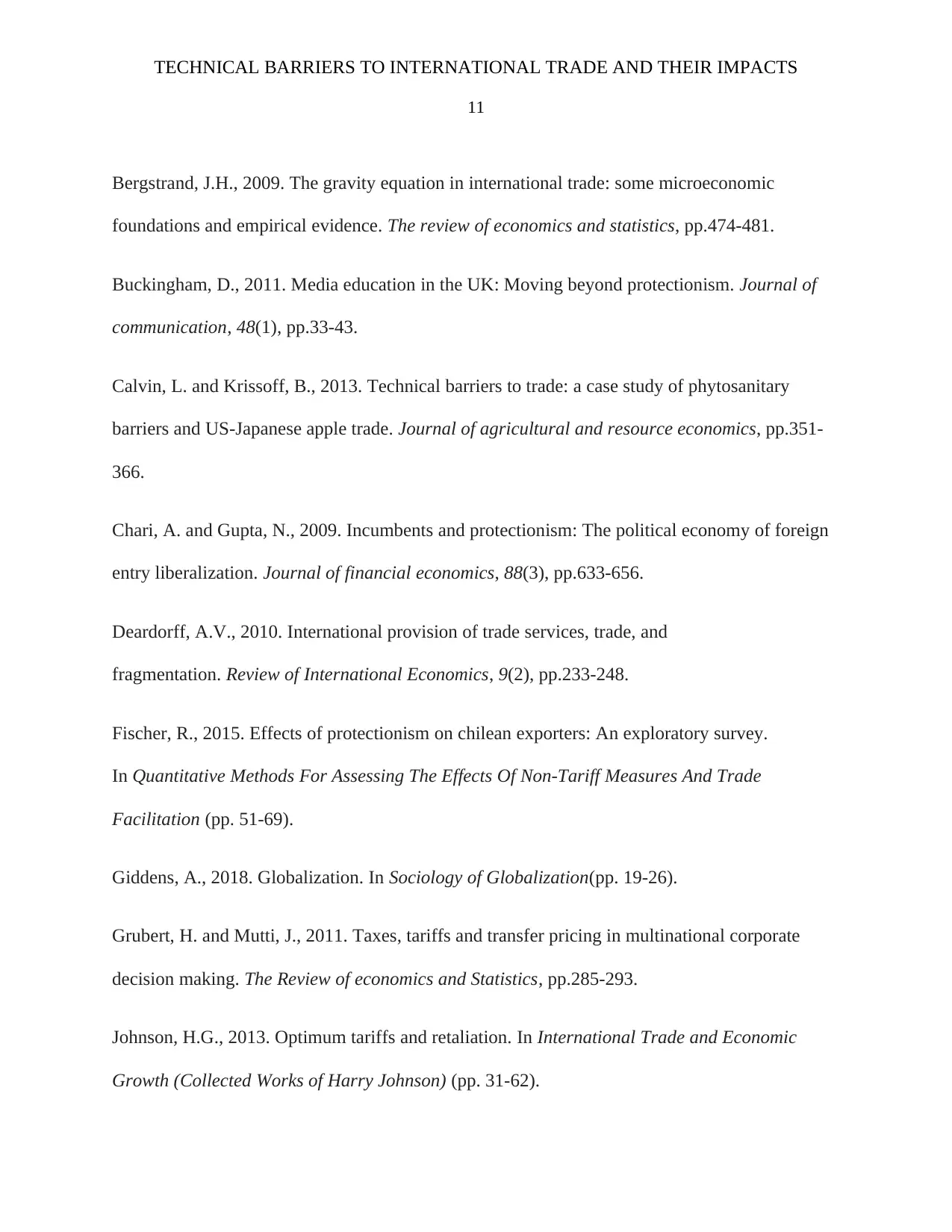
TECHNICAL BARRIERS TO INTERNATIONAL TRADE AND THEIR IMPACTS
11
Bergstrand, J.H., 2009. The gravity equation in international trade: some microeconomic
foundations and empirical evidence. The review of economics and statistics, pp.474-481.
Buckingham, D., 2011. Media education in the UK: Moving beyond protectionism. Journal of
communication, 48(1), pp.33-43.
Calvin, L. and Krissoff, B., 2013. Technical barriers to trade: a case study of phytosanitary
barriers and US-Japanese apple trade. Journal of agricultural and resource economics, pp.351-
366.
Chari, A. and Gupta, N., 2009. Incumbents and protectionism: The political economy of foreign
entry liberalization. Journal of financial economics, 88(3), pp.633-656.
Deardorff, A.V., 2010. International provision of trade services, trade, and
fragmentation. Review of International Economics, 9(2), pp.233-248.
Fischer, R., 2015. Effects of protectionism on chilean exporters: An exploratory survey.
In Quantitative Methods For Assessing The Effects Of Non-Tariff Measures And Trade
Facilitation (pp. 51-69).
Giddens, A., 2018. Globalization. In Sociology of Globalization(pp. 19-26).
Grubert, H. and Mutti, J., 2011. Taxes, tariffs and transfer pricing in multinational corporate
decision making. The Review of economics and Statistics, pp.285-293.
Johnson, H.G., 2013. Optimum tariffs and retaliation. In International Trade and Economic
Growth (Collected Works of Harry Johnson) (pp. 31-62).
11
Bergstrand, J.H., 2009. The gravity equation in international trade: some microeconomic
foundations and empirical evidence. The review of economics and statistics, pp.474-481.
Buckingham, D., 2011. Media education in the UK: Moving beyond protectionism. Journal of
communication, 48(1), pp.33-43.
Calvin, L. and Krissoff, B., 2013. Technical barriers to trade: a case study of phytosanitary
barriers and US-Japanese apple trade. Journal of agricultural and resource economics, pp.351-
366.
Chari, A. and Gupta, N., 2009. Incumbents and protectionism: The political economy of foreign
entry liberalization. Journal of financial economics, 88(3), pp.633-656.
Deardorff, A.V., 2010. International provision of trade services, trade, and
fragmentation. Review of International Economics, 9(2), pp.233-248.
Fischer, R., 2015. Effects of protectionism on chilean exporters: An exploratory survey.
In Quantitative Methods For Assessing The Effects Of Non-Tariff Measures And Trade
Facilitation (pp. 51-69).
Giddens, A., 2018. Globalization. In Sociology of Globalization(pp. 19-26).
Grubert, H. and Mutti, J., 2011. Taxes, tariffs and transfer pricing in multinational corporate
decision making. The Review of economics and Statistics, pp.285-293.
Johnson, H.G., 2013. Optimum tariffs and retaliation. In International Trade and Economic
Growth (Collected Works of Harry Johnson) (pp. 31-62).
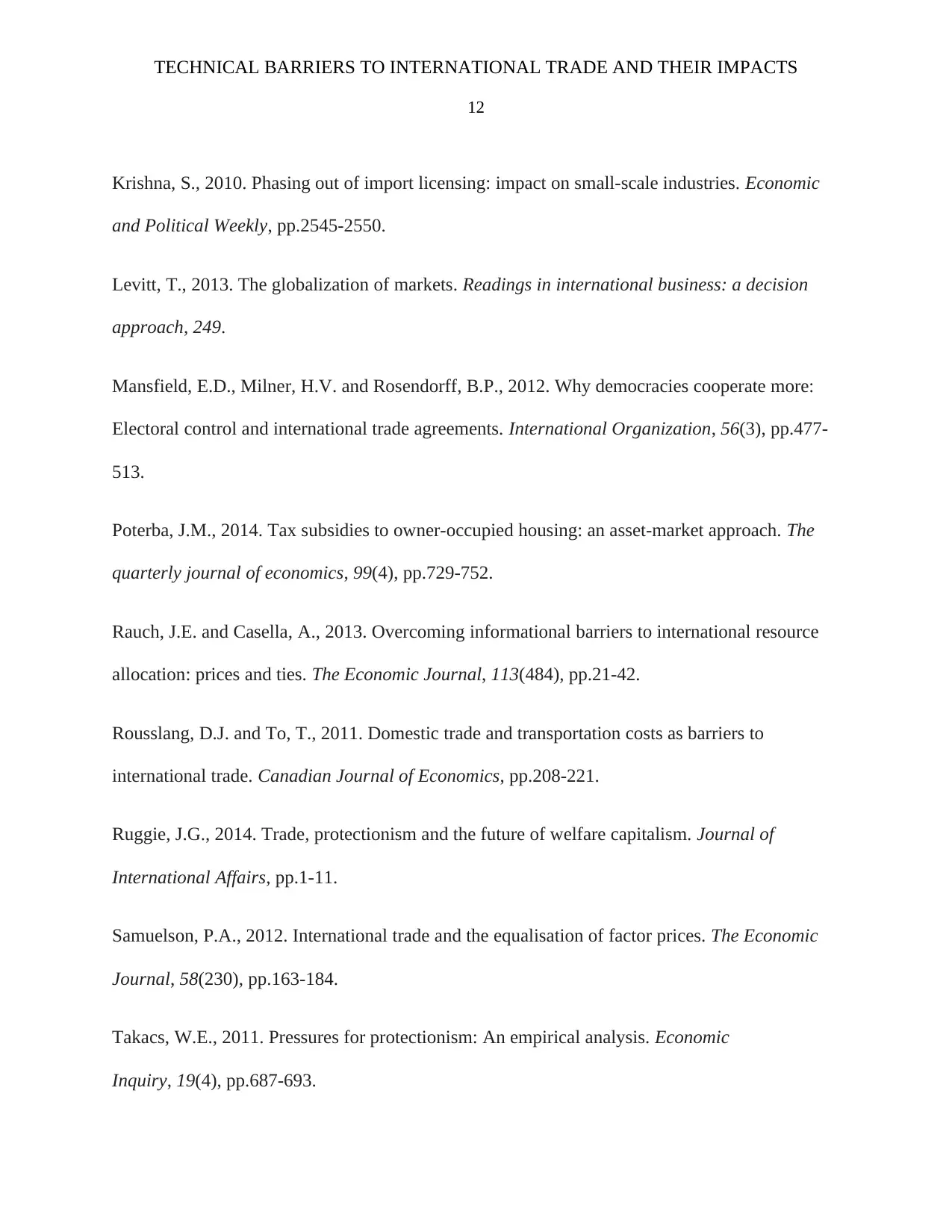
TECHNICAL BARRIERS TO INTERNATIONAL TRADE AND THEIR IMPACTS
12
Krishna, S., 2010. Phasing out of import licensing: impact on small-scale industries. Economic
and Political Weekly, pp.2545-2550.
Levitt, T., 2013. The globalization of markets. Readings in international business: a decision
approach, 249.
Mansfield, E.D., Milner, H.V. and Rosendorff, B.P., 2012. Why democracies cooperate more:
Electoral control and international trade agreements. International Organization, 56(3), pp.477-
513.
Poterba, J.M., 2014. Tax subsidies to owner-occupied housing: an asset-market approach. The
quarterly journal of economics, 99(4), pp.729-752.
Rauch, J.E. and Casella, A., 2013. Overcoming informational barriers to international resource
allocation: prices and ties. The Economic Journal, 113(484), pp.21-42.
Rousslang, D.J. and To, T., 2011. Domestic trade and transportation costs as barriers to
international trade. Canadian Journal of Economics, pp.208-221.
Ruggie, J.G., 2014. Trade, protectionism and the future of welfare capitalism. Journal of
International Affairs, pp.1-11.
Samuelson, P.A., 2012. International trade and the equalisation of factor prices. The Economic
Journal, 58(230), pp.163-184.
Takacs, W.E., 2011. Pressures for protectionism: An empirical analysis. Economic
Inquiry, 19(4), pp.687-693.
12
Krishna, S., 2010. Phasing out of import licensing: impact on small-scale industries. Economic
and Political Weekly, pp.2545-2550.
Levitt, T., 2013. The globalization of markets. Readings in international business: a decision
approach, 249.
Mansfield, E.D., Milner, H.V. and Rosendorff, B.P., 2012. Why democracies cooperate more:
Electoral control and international trade agreements. International Organization, 56(3), pp.477-
513.
Poterba, J.M., 2014. Tax subsidies to owner-occupied housing: an asset-market approach. The
quarterly journal of economics, 99(4), pp.729-752.
Rauch, J.E. and Casella, A., 2013. Overcoming informational barriers to international resource
allocation: prices and ties. The Economic Journal, 113(484), pp.21-42.
Rousslang, D.J. and To, T., 2011. Domestic trade and transportation costs as barriers to
international trade. Canadian Journal of Economics, pp.208-221.
Ruggie, J.G., 2014. Trade, protectionism and the future of welfare capitalism. Journal of
International Affairs, pp.1-11.
Samuelson, P.A., 2012. International trade and the equalisation of factor prices. The Economic
Journal, 58(230), pp.163-184.
Takacs, W.E., 2011. Pressures for protectionism: An empirical analysis. Economic
Inquiry, 19(4), pp.687-693.

TECHNICAL BARRIERS TO INTERNATIONAL TRADE AND THEIR IMPACTS
13
Tripp, A.M. and Kang, A., 2009. The global impact of quotas: On the fast track to increased
female legislative representation. Comparative Political Studies, 41(3), pp.338-361.
13
Tripp, A.M. and Kang, A., 2009. The global impact of quotas: On the fast track to increased
female legislative representation. Comparative Political Studies, 41(3), pp.338-361.
1 out of 13
Related Documents
Your All-in-One AI-Powered Toolkit for Academic Success.
+13062052269
info@desklib.com
Available 24*7 on WhatsApp / Email
![[object Object]](/_next/static/media/star-bottom.7253800d.svg)
Unlock your academic potential
© 2024 | Zucol Services PVT LTD | All rights reserved.




